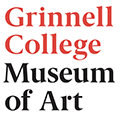-
Artworks

Paul Mpagi Sepuya
American, b. 1982
Darkroom Mirror (_2070527), 2017
Archival pigment print
32 x 24 in. (81.28 x 60.96 cm)
© Paul Mpagi Sepuya. Grinnell College Museum of Art Collection (2021.022)
“The artist in his studio” has long been a subject matter for artists themselves. The studio is a self-styled (and self-governed) locus of creativity, agency, and influence, perhaps unique in an artist’s milieu in its inhospitality to critique or reproach. It is the site where authorship reigns in the absence of naysayers, other than the voice in the artist’s own head, and where the boundaries of propriety historically have been interrogated, applied or surrendered for the cause of art. Sepuya’s studio is populated by friends, often artists themselves, who represent themselves in his tableau of community with a frisson of artistic energy, potential, and permission. At first glance the photographs suggest an observer’s gaze, as if we the viewers are somehow present, or even pressing the shutter button. But in fact the artist himself is the sole author, aiming his camera at a mirror, one that “sees” all yet records nothing. In the words of the artist:
They at first appear inviting but they really don't care about the viewer. They're completely made within an enclosed circuit. The making, the looking, everything is included there.
As you're looking at them, it becomes revealed that you're looking at the surface of a mirror. Semantically, you should be incorporated into the formal composition of the image on the surface of a mirror, but you are foreclosed from this space, and the only ways to enter into it are: you can either understand the structures of photography; you can relate to the space through the way in which it relates to other queer social sexual spaces; or you can enter into them through an understanding of a feeling of them, or a photo-historical conceptual framework. The point of recognition relies on your proximity to the subject depicted, which might only be partial or full. There are these three things you're negotiating — the space, the making, the looking — and the mirror makes it really apparent.
1of 7


